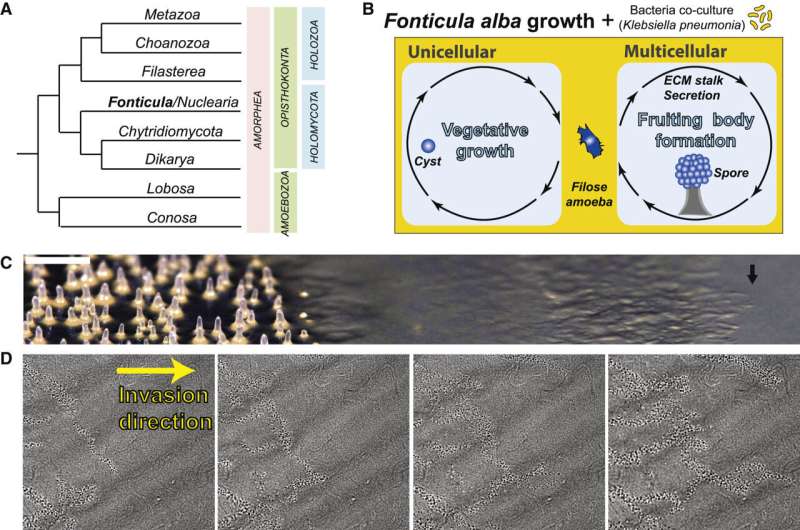F. alba invades virgin bacterial sources collectively (A) Tree approximating F. alba location in eukaryotic evolution (for a more detailed tree, see Galindo et al.18 and Brown et al.19). (B) Schematic of the known life cycle of F. alba. (C) Macro photograph of an F. alba colony radius growing on a plate; original sorocarp was placed left, and invasion into the bacterial resource is rightward (arrow marks the colony front). Scale bars, 1 mm. (D) Montage cell organization at the invasion front over time. Scale bars, 100 μm. (E) Maximal intensity z stack of a confocal section of a phalloidin-stained collective at the colony front. Colored boxes show enlarged single planes of individual cell-cell contacts of corresponding colored regions. Scale bars, 5 μm. (F) SEM region of two cell-cell interfaces (yellow arrowheads) present at the colony front. Scale bars, 5 μm. Credit: Current Biology (2022). DOI: 10.1016/j.cub.2022.03.018
A team of researchers from the University of Geneva and Aix Marseille University has found that the slime mold Fonticula alba forms a multicellular, dynamic collective when feeding on bacteria. In their paper published in the journal Current Biology, the group describes their study of the slime mold's life cycle and what they discovered when they introduced it to bacteria.
F. alba is a rare form of slime mold that has only ever been seen in the wild once, in a dog feces sample collected in the 1960s. Prior study has shown it to be a closer relative of fungi than are other slime molds. Other researchers had also found that like most other slime molds, it exists as a single-cell life form and that it feeds on bacteria like that found in dog feces. It also combines with others of its kind to form an entity that releases spores as a means of propagation. In this new effort, the researchers sought to learn more about its life cycle.
To discover what happens when the slime mold encountered bacteria, the researchers collected samples grown in a lab and exposed them to Klebsiella pneumonia at different points in their life cycle. As F. alba was exposed to the bacteria during its near-end-of-life phase, the researchers found it became much more active. Exposure to the bacteria, the researchers found, encouraged the slime mold to aggregate. As it did so, it began feeling its way into the bacterial mass, sending out filaments that crept through parts of the bacteria colony, seeking out more easy sources of food. A closer look showed that there were leader and follower F. alba in the filaments. The researchers found that disrupting the leader of a filament using a laser resulted in disordered movement and the filament was unable to recover. But when they did the same to followers, it made little difference.
The researchers note that the movement of the filaments through the bacterial colony was reminiscent of the way cancer cells invade bodily tissue.
More information: Christopher Toret et al, The cellular slime mold Fonticula alba forms a dynamic, multicellular collective while feeding on bacteria, Current Biology (2022). DOI: 10.1016/j.cub.2022.03.018
Journal information: Current Biology
© 2022 Science X Network























